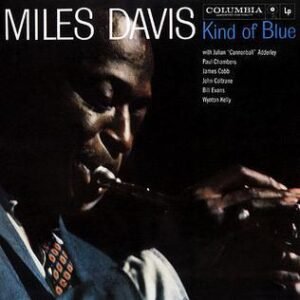5 great albums to listen to while in self-isolation

Since the start of the COVID-19 pandemic, have you spent any time in self-isolation?
I have, and it is something that many of us have had to do since the start of the pandemic ten months ago. I also imagine that, for those who felt well enough to want to be moving around, it was (or still is) hard to try and occupy that two-week period without getting completely bored or losing your mind from idleness.
Some likely turned to the endlessness of a streaming service’s recommended section, watched a rerun of their favourite film or show for the nth time; others, like myself, would have turned to listening to music constantly to help pass that time.
With that being said, here is a list of five albums that personally got me through my period of self-isolation, which I feel are also appropriate for the seemingly unreal times we find ourselves in.
Ambient 1: Music for Airports – Brian Eno (1978)

Despite its subtitle, Music for Airports is not merely music to listen to while going through a busy airport terminal, but was created, according to Brian Eno, as part of his mission to create music which would “induce calm and a space to think”. In such times where our minds are exhausted from media oversaturation, weary from a seemingly never-ending pandemic, and nervous from the omnipresence of political and economic instability, this ideal seems more vital than ever.
The first album to be explicitly created under the label ambient music, the four tracks which make up Music for Airports can only be described as formless slices of sonic ecstasy, built up from only electric and acoustic piano, wordless vocals (on “2/1” and “1/2”), and a synthesizer.
Despite a lack of lyrics, rhythm, form, or even a time signature, Music for Airports is remarkably easy to get lost in and is one of those rare albums that, because of its free-forming, ethereal nature, only adds value to those who can appreciate listening to it in a myriad of situations. This ideal is even encouraged by Eno himself in the liner notes of the initial American release of the album:
“Ambient music must be able to accommodate many levels of listening attention without enforcing one in particular; it must be as ignorable as it is interesting.”
Simply put, it is one of the most entrancing listening experiences ever put to wax.
Stop Making Sense – Talking Heads (1984)

Taken from a December 1983 recording of shows at The Pantages Theatre, Hollywood over four nights, Stop Making Sense is widely seen as being one of, if not the best, live albums and concert films of all time. It makes this list for the same reason it has received its lasting praise: it is the perfect soundtrack to forget about everything and simply let your mind run loose, if only for a little while.
Featuring tracks from all Talking Heads’ five albums released up to that point, it is also an excellent starting point for those wanting to give their music a chance.
The album starts off with a solo acoustic version of the Heads’ debut single, “Psycho Killer”, before the ensemble band takes the stage one-by-one with each passing song. All the while, the crew for the band carts the heavy equipment on stage as they perform, which helps to ramp up momentum which finally hits fifth-gear by the sixth track, “Burning Down the House”.
The rock solid husband-wife rhythm section of Chris Frantz (drums) and Tina Weymouth (bass) is among the most underrated in all of popular music and were the key to the Heads’ live shows finding a delicate balance between mindless noise and cohesive cacophony. However, it is easy to overlook when such a fascinatingly eccentric frontman like Byrne is always front and centre.
For added context, check out the band’s performance of Remain in Light’s opening track “Born Under Punches”, performed in Rome during their 1980 tour.
Highlights include the existentially sombre “Heaven” (from Fear of Music), the addictively funky “Girlfriend is Better” (which sees Byrne don the now iconic “big suit”), the gorgeously romantic “This Must Be the Place” (both from Speaking in Tongues), and “Genius of Love”, a Tom Tom Club track featuring Weymouth on vocals.
However, it is the Remain in Light cut, “Crosseyed and Painless”, which closes the album and film, that is the most noteworthy in context to the current times, with the rapped bridge by Byrne stating how facts “come with points of view”, with them not doing “what I want them to” while twisting “the truth around” – lyrics which are extremely relevant in the age of both COVID-19 and fake news.
In short, Stop Making Sense is a challenge of trying not to dance, head bop, foot tap, or do anything that shows how infectiously catchy it is. Chances are if you give it a go, you will fail.
The outtakes of “Cities” and “Big Business/I Zimbra” are also well worth checking out.
Kind of Blue – Miles Davis (1959)

Miles Davis’ 1959 modal jazz masterpiece is on this list for similar reasons as Brian Eno’s Music for Airports: it is one of the best albums to play as background music, which is both simple to get yourself lost within and equally rewarding to listen to with intent.
However, Kind of Blue is also representative of the now lost art of live performance, which has also been severely affected by the pandemic.
Despite being a studio album, its five pieces were all improvised from themes and chords laid out by Davis only hours before recording, with next-to-no rehearsals taking place before the album’s recording sessions, enhancing its structure with an undeniably organic feel, which could be often mistaken for a live performance by a casual listener.
This not only highlights the immense talent within the Miles Davis Sextet (augmented from a quintet in 1958), but gives Kind of Blue a vitality which has almost never been replicated on a record, either before or since.
“So What” grips you with its simple call and response motif between Paul Chambers’ double bass and Davis’ trumpet, while “All Blues” is a masterclass in ensemble performance, with its piano motifs by Bill Evans which subtly run underneath the saxophone vamps of John Coltrane and Cannonball Adderley, alongside Davis’ trumpet solos.
Kind of Blue is a perfect example of improvised performance on a studio release – melodic yet simple, experimental yet accessible, and most of all, grippingly unfrogettable. There is a reason it is regarded as the definitive jazz album.
Whatever People Say I Am, That’s What I’m Not – Arctic Monkeys (2006)

Fifteen years on, Whatever People Say I Am, That’s What I’m Not remains a forty-minute modern rock masterpiece which documented both a period and a culture, a culture which has ceased to exist since the first lockdowns started last March.
A loose concept album centring around Monkeys’ frontman Alex Turner’s observations of night culture in his native Sheffield, its vivid and satirical depiction of said culture of the mid-2000s has only become more accurate as time has gone on.
The criminally underrated “Dancing Shoes” stands as one of the most accurately witty songs in recent memory, perfectly describing how single people always try to pull on a night out no matter how they try to hide it. With the current pandemic still ongoing, it is not too much of a stretch to say most people will likely not mask that intention once the pubs and clubs reopen.
What makes Whatever People Say I Am stand above other albums with a similar concept is the self-awareness that Turner delivers his lines with, acknowledging that his bandmates came from the same sort of background as those very people, highlighted by the closing track “A Certain Romance”.
This level of relatability, along with its grippingly infectious indie rock/post-punk revival sound, helped make the album the fastest-selling debut album in British history upon release.
An album which once epitomised the events of any Friday or Saturday night out now feels not only like a distant memory, but something many yearn to experience again in the not-too-distant future.
Homogenic – Björk (1997)

Released as the Icelandic songstress’ third album, Homogenic resembles the emotional sparseness which has come about because of the pandemic, something which is shared with Radiohead’s Kid A, an album heavily inspired by Björk’s 1997 album.
While Kid A is a worthy honourable mention for this list, with its distant and (occasional) robotic feel, there is an argument that Homogenic is a better choice of album; it chooses to embrace its emotions and humanity, unlike Kid A, which is single-handedly propelled forward by Björk herself.
Homogenic’s core themes primarily revolve around love and home, two topics that would likely be at the forefront of many people’s minds over the last few months. Its sonic palette is heavily inspired by the natural landscapes of Björk’s native Iceland, while tracks such as “Unravel” and “All Is Full of Love” have lyrics which lament and embrace the idea of love respectively.
While icy strings, stuttering beats, and glitchy synths dominate this art pop opus, Björk’s impassioned soprano voice shatters its glacial feel like glass, particularly on the Bondian “Bachelorette” and glitchy “5 Years”.
Homogenic is the ideal soundtrack to a self-reflective journey, which forces the listener to look inward in order to move on from an important, yet difficult period in their life.